Freckles are a common skin condition that can be a source of frustration for many individuals. While freckles are typically harmless, some individuals may choose to have them removed for cosmetic reasons. Freckle removal can be done through a variety of methods, including laser therapy and cryotherapy. In this article, we will explore the recovery process from freckle removal and provide insights into how to speed up the healing process for a smooth and successful recovery.
What is Freckle Removal?
Freckle removal is a cosmetic procedure that involves the removal of freckles from the skin. This can be done through a variety of methods, including laser therapy and cryotherapy. These methods work by targeting the pigmented cells in the freckles, causing them to break down and fade over time.
Recovery Process from Freckle Removal:
The recovery process from freckle removal can vary depending on the method used and the extent of the treatment. In general, the recovery process can be broken down into several stages:
Immediately after the procedure: After the freckle removal procedure, the treated area may be red and swollen. The skin may also be sensitive to the touch and feel slightly sore.
First week after the procedure: During the first week after the procedure, the treated area may scab over and become itchy. It is important not to scratch or pick at the scabs, as this can slow down the healing process and increase the risk of infection.
Second week after the procedure: During the second week after the procedure, the scabs will begin to fall off, revealing new, pink skin underneath. It is important to keep the area clean and moisturized during this time to promote healing.
Third and fourth weeks after the procedure: During the third and fourth weeks after the procedure, the new skin will continue to heal and may still be slightly pink or red. It is important to continue to keep the area moisturized and protected from the sun during this time.
Speeding Up the Healing Process:
While the recovery process from freckle removal can take several weeks, there are several steps that can be taken to speed up the healing process and promote optimal results. These steps include:
Keeping the area clean: It is important to keep the treated area clean and dry to prevent infection and promote healing.
Moisturizing the area: Keeping the area moisturized can help prevent dryness and promote healing. Use a gentle, fragrance-free moisturizer to keep the area hydrated.
Avoiding sun exposure: Sun exposure can slow down the healing process and increase the risk of scarring. It is important to avoid sun exposure and wear protective clothing and sunscreen when spending time outdoors.
Avoiding strenuous activity: Strenuous activity can increase blood flow to the treated area, which can slow down the healing process. It is important to avoid strenuous activity for several days after the procedure.
Conclusion:
Freckle removal is a cosmetic procedure that can help individuals achieve a smoother and more even complexion. The recovery process from freckle removal can take several weeks, but by following these tips for speeding up the healing process, individuals can promote optimal results and achieve a smooth and successful recovery. As always, it is important to consult with a qualified healthcare professional before undergoing any cosmetic procedure.
FAQs
1. What are the side effects of freckle removal?
Common side effects of freckle removal procedures, such as laser therapy or cryotherapy, may include temporary redness, swelling, and mild discomfort at the treatment site. In some cases, patients may experience temporary hyperpigmentation or hypopigmentation, where the skin becomes darker or lighter than the surrounding area. It’s essential to follow post-treatment care instructions provided by your dermatologist to minimize the risk of complications and ensure optimal healing.
2. Is freckle removal painful?
The level of discomfort experienced during freckle removal depends on the individual’s pain tolerance and the specific treatment method used. While some people may experience mild discomfort or a stinging sensation during laser therapy or cryotherapy, topical anesthetics or cooling devices may be used to help minimize pain during the procedure. Most patients find that any discomfort is tolerable and subsides shortly after treatment.
3. How effective is freckle removal?
The effectiveness of freckle removal treatments varies depending on factors such as the type of freckles, the chosen treatment method, and individual skin characteristics. Laser therapy, cryotherapy, and chemical peels are among the most common methods used to remove freckles, and they can yield significant improvement in the appearance of freckles with multiple sessions. However, it’s essential to manage expectations and understand that complete removal may not always be possible, especially for deeper or more extensive freckles.
4. What happens after laser freckle removal?
After laser freckle removal, it’s normal to experience some redness, swelling, and minor discomfort at the treatment site. The skin may also appear darker or crusty temporarily as it heals. It’s crucial to follow post-treatment care instructions provided by your dermatologist, which may include applying soothing ointments, avoiding sun exposure, and using sunscreen to protect the treated area. Over time, the treated freckles will gradually fade, and the skin will regain its normal appearance.


